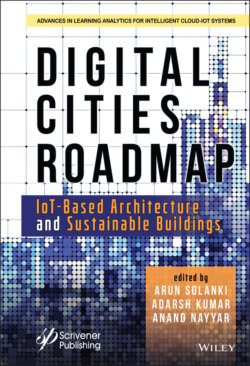Читать книгу Digital Cities Roadmap - Группа авторов - Страница 2
Table of Contents
Оглавление1 Cover
2 Title Page
3 Copyright
4 Preface
5 1 The Use of Machine Learning for Sustainable and Resilient Buildings 1.1 Introduction of ML Sustainable Resilient Building 2 1.2 Related Works 1.3 Machine Learning 1.4 What is Resilience? 1.5 Sustainability and Resilience of Engineered System 12 1.6 Community and Quantification Metrics, Resilience and Sustainability Objectives 1.7 Structure Engineering Dilemmas and Resilient Epcot 21 1.8 Development of Risk Informed Criteria for Building Design Hurricane Resilient on Building 1.9 Resilient Infrastructures Against Earthquake and Tsunami Multi-Hazard 1.10 Machine Learning With Smart Building 1.11 Conclusion and Future Research References
6 2 Fire Hazard Detection and Prediction by Machine Learning Techniques in Smart Buildings (SBs) Using Sensors and Unmanned Aerial Vehicles (UAVs) 2.1 Introduction 2.2 Literature Review 2.3 Experimental Methods 2.4 Results 2.5 Conclusion and Future Work References
7 3 Sustainable Infrastructure Theories and Models 3.1 Introduction to Data Fusion Approaches in Sustainable Infrastructure 3.2 Smart City Infrastructure Approaches 3.3 Theories and Models 3.4 Case Studies 3.5 Conclusion and Future Scope References
8 4 Blockchain for Sustainable Smart Cities 4.1 Introduction 4.2 Smart City 4.3 Blockchain 4.4 Use Cases of Smart City Implementing Blockchain 4.5 Conclusion References
9 5 Contextualizing Electronic Governance, Smart City Governance and Sustainable Infrastructure in India: A Study and Framework 5.1 Introduction 5.2 Related Works 5.3 Related E-Governance Frameworks 5.4 Proposed Smart Governance Framework 5.5 Results Discussion References
10 6 Revolutionizing Geriatric Design in Developing Countries: IoT-Enabled Smart Home Design for the Elderly 6.1 Introduction to Geriatric Design 6.2 Background 6.3 Need for Smart Homes: An Assessment of Requirements for the Elderly-Activity Mapping 6.4 Schematic Design for a Nesting Home: IoT-Enabled Smart Home for Elderly People 6.5 Worldwide Elderly Smart Homes 6.6 Conclusion and Future Scope References
11 7 Sustainable E-Infrastructure for Blockchain-Based Voting System 7.1 Introduction 7.2 Related Works 7.3 System Design 7.4 Experimentation 7.5 Findings & Results 7.6 Conclusion and Future Scope References
12 8 Impact of IoT-Enabled Smart Cities: A Systematic Review and Challenges 8.1 Introduction 8.2 Recent Development in IoT Application for Modern City 8.3 Classification of IoT-Based Smart Cities 8.4 Impact of 5G Technology in IT, Big Data Analytics, and Cloud Computing 8.5 Research Advancement and Drawback on Smart Cities 8.6 Summary of Smart Cities and Future Research Challenges and Their Guidelines 8.7 Conclusion and Future Direction References
13 9 Indoor Air Quality (IAQ) in Green Buildings, a Pre-Requisite to Human Health and Well-Being 9.1 Introduction 9.2 Pollutants Responsible for Poor IAQ 9.3 Health Impacts of Poor IAQ 9.4 Strategies to Maintain a Healthy Indoor Environment in Green Buildings 9.5 Conclusion and Future Scope References
14 10 An Era of Internet of Things Leads to Smart Cities Initiatives Towards Urbanization 10.1 Introduction: Emergence of a Smart City Concept 10.2 Components of Smart City 10.3 Role of IoT in Smart Cities 10.4 Sectors, Services Related and Principal Issues for IoT Technologies 10.5 Impact of Smart Cities 10.6 Key Applications of IoT in Smart Cities 10.7 Challenges 10.8 Conclusion References
15 11 Trip-I-Plan: A Mobile Application for Task Scheduling in Smart City’s Sustainable Infrastructure 11.1 Introduction 11.2 Smart City and IoT 11.3 Mobile Computing for Smart City 11.4 Smart City and its Applications 11.5 Smart Tourism in Smart City 11.6 Mobile Computing-Based Smart Tourism 11.7 Case Study: A Mobile Application for Trip Planner Task Scheduling in Smart City’s Sustainable Infrastructure 11.8 Experimentation and Results Discussion 11.9 Conclusion and Future Scope References
16 12 Smart Health Monitoring for Elderly Care in Indoor Environments 12.1 Introduction 12.2 Sensors 12.3 Internet of Things and Connected Systems 12.4 Applications 12.5 Case Study 12.6 Conclusion 12.7 Discussion References
17 13 A Comprehensive Study of IoT Security Risks in Building a Secure Smart City 13.1 Introduction 13.2 Related Works 13.3 Overview of IoT System in Smart Cities 13.4 IoT Security Prerequisite 13.5 IoT Security Areas 13.6 IoT Security Threats 13.7 Review of ML/DL Application in IoT Security 13.8 Challenges 13.9 Future Prospects 13.10 Conclusion References
18 14 Role of Smart Buildings in Smart City—Components, Technolo Indicators, Challenges, Future Research Opportunities 14.1 Introduction 14.2 Literature Review 14.3 Components of Smart Cities 14.4 Characteristics of Smart Buildings 14.5 Supporting Technology 14.6 Key Performance Indicators of Smart City 14.7 Challenges While Working for Smart City 14.8 Future Research Opportunities in Smart City 14.9 Conclusion References
19 15 Effects of Green Buildings on the Environment 15.1 Introduction 15.2 Sustainability and the Building Industry 15.3 Goals of Green Buildings 15.4 Impacts of Classical Buildings that Green Buildings Seek to Rectify 15.5 Green Buildings in India 15.6 Conclusion References
20 Index
21 End User License Agreement
